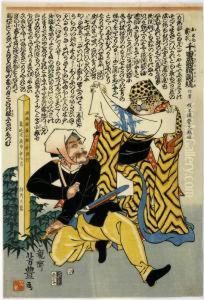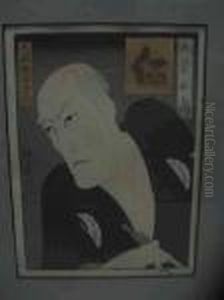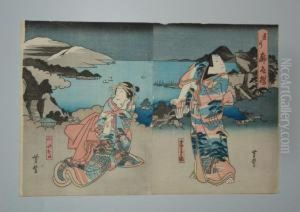Utagawa Yoshitoyo Paintings
Utagawa Yoshitoyo was a Japanese ukiyo-e artist known for his works during the late Edo period. Born in 1830, Yoshitoyo was part of the Utagawa school, a prominent lineage of Japanese woodblock print artists that profoundly influenced the genre. Despite the prominence of the school, Yoshitoyo is often considered a lesser-known figure compared to his contemporaries, such as Utagawa Hiroshige and Utagawa Kuniyoshi, yet his works offer valuable insights into the cultural and societal aspects of Japan during his time.
Yoshitoyo's artistic career unfolded in an era marked by significant transformation and turmoil within Japan, as the country gradually opened up to the West and began to modernize. This period, leading up to the Meiji Restoration of 1868, was characterized by a mix of excitement and anxiety about the future, themes that occasionally surfaced in Yoshitoyo's works. He specialized in yakusha-e (actor prints) and musha-e (warrior prints), capturing the flourishing kabuki theater and the romanticized past of the samurai class. His prints are distinguished by their dynamic composition, vivid colors, and detailed portrayal of figures, demonstrating his mastery of the ukiyo-e style.
Yoshitoyo's contributions to the ukiyo-e genre include not only historical and actor prints but also illustrations of animals and mythical creatures, showcasing his versatility as an artist. Despite his relatively short life, dying in 1866 at the age of 36, Yoshitoyo managed to produce a body of work that was both reflective of his times and innovative in its approach. His ability to infuse traditional subjects with a fresh perspective ensured that his prints remained popular among the Japanese public, even as the country underwent profound changes.
Unfortunately, much like many artists of his era, detailed records of Yoshitoyo's life and career are scarce, and his work has been somewhat overshadowed by the more famous members of the Utagawa school. Nevertheless, his surviving prints continue to be appreciated by collectors and scholars for their artistic merit and historical significance. They offer a glimpse into the transitional period of Japanese history and the enduring appeal of the ukiyo-e art form. Through his artwork, Utagawa Yoshitoyo has left an indelible mark on the rich tapestry of Japanese cultural history, embodying the complexity and beauty of a world caught between tradition and modernity.


